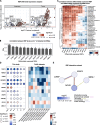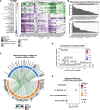Multiple regulatory events contribute to a widespread circular RNA downregulation in precancer and early stage of colorectal cancer development
- PMID: 39980011
- PMCID: PMC11844049
- DOI: 10.1186/s40364-025-00744-8
Multiple regulatory events contribute to a widespread circular RNA downregulation in precancer and early stage of colorectal cancer development
Abstract
Background: Early detection of colorectal cancer (CRC) significantly improves its management and patients' survival. Circular RNAs (circRNAs) are peculiar covalently closed transcripts involved in gene expression modulation whose dysregulation has been extensively reported in CRC cells. However, little is known about their alterations in the early phases of colorectal carcinogenesis.
Methods: In this study, we performed an integrative analysis of circRNA profiles in RNA-sequencing (RNA-Seq) data of 96 colorectal cancers, 27 adenomas, and matched adjacent mucosa tissues. We also investigated the levels of cognate linear transcripts and those of regulating RNA-binding proteins (RBPs). Levels of circRNA-interacting microRNAs (miRNAs) were explored by integrating data of small RNA-Seq performed on the same samples.
Results: Our results revealed a significant dysregulation of 34 circRNAs (paired adj. p < 0.05), almost exclusively downregulated in tumor tissues and, prevalently, in early disease stages. This downregulation was associated with decreased expression of circRNA host genes and those encoding for RBPs involved in circRNA biogenesis, including NOVA1, RBMS3, and MBNL1. Guilt-by-association analysis showed that dysregulated circRNAs correlated with increased predicted activity of cell proliferation, DNA repair, and c-Myc signaling pathways. Functional analysis showed interactions among dysregulated circRNAs, RBPs, and miRNAs, which were supported by significant correlations among their expression levels. Findings were validated in independent cohorts and public datasets, and the downregulation of circLPAR1(2,3) and circLINC00632(5) was validated by ddPCR.
Conclusions: These results support that multiple altered regulatory mechanisms may contribute to the reduction of circRNA levels that characterize early colorectal carcinogenesis.
Keywords: Adenoma; Circular RNAs; Colorectal cancer; Precancerous lesions; RNA-binding proteins; RNA-sequencing.
© 2025. The Author(s).
Conflict of interest statement
Declarations. Ethics approval and consent to participate: The local ethics committees of Azienda Ospedaliera SS. Antonio e Biagio e C. Arrigo of Alessandria (Italy, protocol no. Colorectal miRNA CEC2014), Masaryk Memorial Cancer Institute (protocol no. 2018/865/MOU), and Masaryk University of Brno (Czech Republic, protocol no. EKV2019-044) approved the study. All patients gave written informed consent following the Declaration of Helsinki before participating in the study. Consent for publication: All authors read and approved the final manuscript. Competing interests: The authors declare no competing interests.
Figures





References
-
- Siegel RL, Wagle NS, Cercek A, Smith RA, Jemal A. Colorectal cancer statistics, 2023. CA Cancer J Clin. 2023;73(3):233–54. - PubMed
-
- Dekker E, Tanis PJ, Vleugels JLA, Kasi PM, Wallace MB. Colorectal cancer. Lancet. 2019;394(10207):1467–80. - PubMed
-
- Dienstmann R, Vermeulen L, Guinney J, Kopetz S, Tejpar S, Tabernero J. Consensus molecular subtypes and the evolution of precision medicine in colorectal cancer. Nat Rev Cancer. 2017;17(2):79–92. - PubMed
Grants and funding
LinkOut - more resources
Full Text Sources

